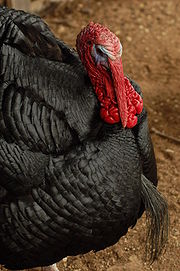
Black (turkey)
Encyclopedia

Breed
A breed is a group of domestic animals or plants with a homogeneous appearance, behavior, and other characteristics that distinguish it from other animals or plants of the same species. Despite the centrality of the idea of "breeds" to animal husbandry, there is no scientifically accepted...
of domestic turkey. The Black was developed in Europe from the first turkeys brought there from North America
North America
North America is a continent wholly within the Northern Hemisphere and almost wholly within the Western Hemisphere. It is also considered a northern subcontinent of the Americas...
by explorers. Despite the monikers of “Spanish
Spain
Spain , officially the Kingdom of Spain languages]] under the European Charter for Regional or Minority Languages. In each of these, Spain's official name is as follows:;;;;;;), is a country and member state of the European Union located in southwestern Europe on the Iberian Peninsula...
and “Norfolk
Norfolk
Norfolk is a low-lying county in the East of England. It has borders with Lincolnshire to the west, Cambridgeshire to the west and southwest and Suffolk to the south. Its northern and eastern boundaries are the North Sea coast and to the north-west the county is bordered by The Wash. The county...
” (England), birds of this type are to be found in many European nations. Originally, black colored turkeys were a relative rarity among New World flocks, but Europeans heavily selected
Selective breeding
Selective breeding is the process of breeding plants and animals for particular genetic traits. Typically, strains that are selectively bred are domesticated, and the breeding is sometimes done by a professional breeder. Bred animals are known as breeds, while bred plants are known as varieties,...
for this trait until it became dominant.
Black turkeys were also present in the holds of ships making the transatlantic crossing from Europe back to the New World
New World
The New World is one of the names used for the Western Hemisphere, specifically America and sometimes Oceania . The term originated in the late 15th century, when America had been recently discovered by European explorers, expanding the geographical horizon of the people of the European middle...
, and were raised by early colonists. Ironically, it is likely that the turkey consumed at the first Thanksgiving
Thanksgiving
Thanksgiving Day is a holiday celebrated primarily in the United States and Canada. Thanksgiving is celebrated each year on the second Monday of October in Canada and on the fourth Thursday of November in the United States. In Canada, Thanksgiving falls on the same day as Columbus Day in the...
meal may have actually been from European birds, rather than Wild Turkey
Wild Turkey
The Wild Turkey is native to North America and is the heaviest member of the Galliformes. It is the same species as the domestic turkey, which derives from the South Mexican subspecies of wild turkey .Adult wild turkeys have long reddish-yellow to grayish-green...
s native to the continent, although these were descendents from said bird.
Later, Blacks were crossed with the Wild Turkey to help produce breeds such as the Bronze
Bronze (turkey)
The Bronze is a breed of domestic turkey. The name refers to its plumage, which bears an iridescent bronze-like sheen. The Bronze had been the most popular turkey throughout most of American history, but waned in popularity beginning in the mid-20th century. Later in its history, the breed was...
, Narragansett, and Slate
Slate (turkey)
The Slate, or Blue Slate, is a breed of domestic turkey known for the slate gray color of its plumage. Lighter birds are sometimes called Lavender turkeys...
. They continued to be a commercially farmed variety in the U.S. until the early 20th century, but fell out of favor after the development of the Broad Breasted Bronze and Broad Breasted White. Fairly common in Europe, they are considered to be an endangered variety of heritage turkey
Heritage turkey
A heritage turkey is one of a variety of strains of domestic turkey which retains historic characteristics that are no longer present in the majority of turkeys raised for consumption since the mid-20th century...
today by the American Livestock Breeds Conservancy
American Livestock Breeds Conservancy
The American Livestock Breeds Conservancy is a nonprofit organization focused on preserving and promoting genetic diversity among rare breeds of livestock...
, and are also included in Slow Food USA's Ark of Taste
Ark of Taste
The Ark of Taste is an international catalogue of heritage foods in danger of extinction which is maintained by the global Slow Food movement. The Ark is designed to preserve at-risk foods that are sustainably produced, unique in taste, and part of a distinct ecoregion...
, a catalog of heritage foods in danger of extinction.

